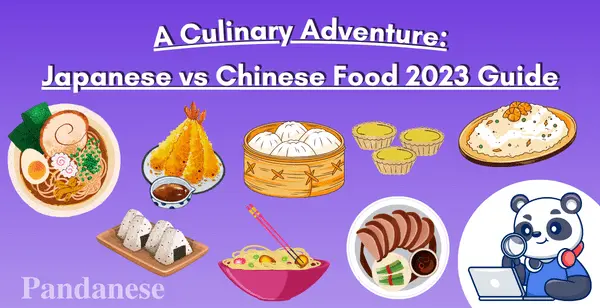
A Culinary Adventure: Japanese vs Chinese Food 2023 Guide
Curious about the difference between Chinese and Japanese cuisines?
We got you covered by comparing their food, cooking techniques, and flavor profile.
So, if you've ever wondered about the nuances of Japanese vs Chinese food, join us on this mouthwatering adventure and discover the enticing world of Asian cuisine in 2023. Let's embark on this flavorful journey together!
Staple foods in Chinese and Japanese food
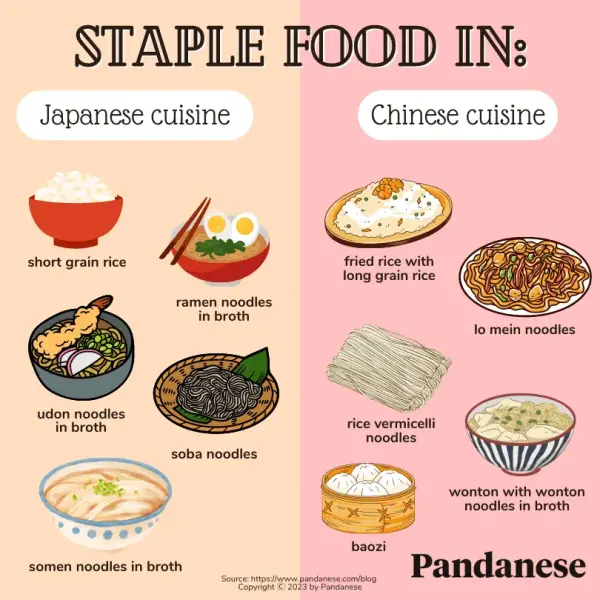
Japanese staple food vs Chinese staple food
Rice and noodles constitute a mainstay of both Japanese and Chinese cuisines, in the same way that bread is fundamental to Western food. Rice and noodles are both common to see in Chinese and Japanese foods.
But how each culture uses these staples can be quite distinct. So let's see how each culture uses them and their food staples.
What is the staple of Japanese food?
Generally, Japanese rice is a short grain; when cooked, it's soft and a little sticky. Japanese uses a variety of noodles depending on the dish. Nothing is done to the rice because it is usually paired with other Japanese dishes.
The most well-known Japanese noodles are ramen, udon, soba, and somen. Each noodle has a different way of being eaten, but these noodles are usually paired with a rich, hot broth or dipped in a cold sauce.
What is the staple food of the Chinese?
Like Japanese cuisine, rice and noodles also play a big role in Chinese cuisine.
Rice in Chinese foods tends to be thin and long. Generally, it is usually mixed in with vegetables, meat, and sauce, but rice can be eaten with many side dishes.
Famous Chinese noodles include:
Chinese egg noodles (捞面—lāo miàn).
Rice Vermicelli noodles (米粉—mǐ fěn).
Wonton noodles (雲吞面—húntun mian).
These noodles are stir-fried with vegetables and meat with a sauce or eaten in soup.
Additionally, baozi (steam bun) and wonton are a staple in Chinese cuisine.
Meat selection: seafood, poultry, and beyond
In Japanese and Chinese cooking, proteins provide the finishing touches that complete a dish. Meat varieties used in each cuisine and how they are cooked and prepared vary greatly, affecting their flavor profiles.
Let’s take a look at what types of meats are preferred for these two cuisines.
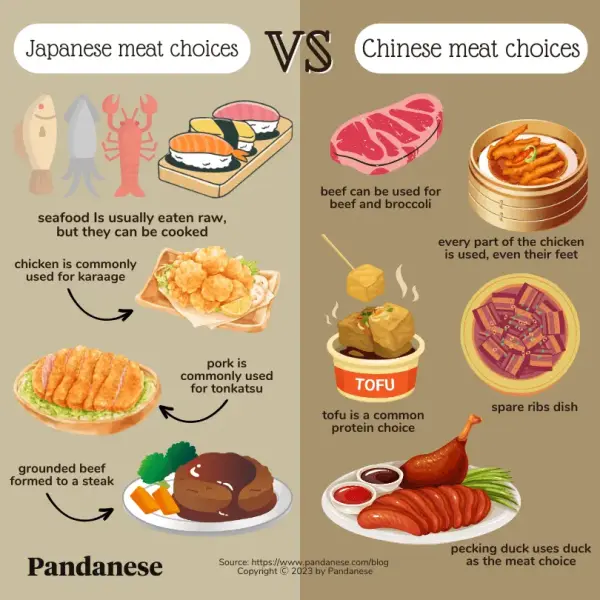
Japanese meat vs Chinese meat selections
Japanese meat selections
For centuries, seafood has been a major protein source for Japanese people. So fish, shrimp, octopus, and squid have been integrated into Japanese food. They are served either raw in sashimi or grilled to cook them.
There are many reasons why meats in Japan are expensive, leading many Japanese people's meat selections to be seafood. But that hasn't stopped Japan from producing iconic dishes such as karaage (fried chicken), tonkatsu (breaded pork cutlet), and hamburger steak (hamburger steak patty).
Chinese meat selections
Chinese cuisine leans more towards beef, pork, and chicken. These meats are cooked by stir frying, deep frying, or braised to be coated in rich and spicy sauce. Well-known Chinese food that combines this meat and cooking method are sweet and sour pork ribs (糖醋排骨—táng cù pái gǔ), and Chinese BBQ pork (叉燒—chā shāo).
Tofu is a protein choice that is not meat but is very popular in China. It can be seen in Mapo Tofu (麻婆豆腐), Stinky Tofu (臭豆腐—chòu dòufu), Crispy Salt and Pepper Tofu (椒盐豆腐—jiāo yán dòufu).
Another meat choice in Chinese food is duck. One of the most famous Chinese duck food is 烤鸭 (kǎo yā) or Peking duck.
Not typically seen in Japanese cooking, but every part of an animal is used for cooking or is eaten, from the meat to the skin, fat, blood, and bones.
Japanese vs Chinese: cooking techniques and cookware
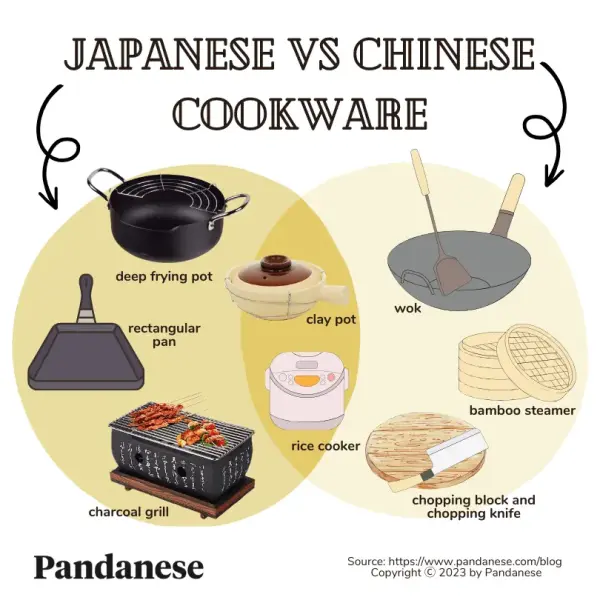
Japanese cookware vs Chinese cookware
Japanese cooking style and cookware
Japanese cooking focuses on simplicity and emphasizes the natural flavors of ingredients—mostly seen with raw fish for sushi. But cooking techniques such as grilling, steaming, and boiling are common to cook, preserve, and bring out the food's flavor.
When looking at traditional Japanese food, one can appreciate the meticulous attention to detail in presentation, as it is believed that the visual appeal is just as important as the taste itself. It emphasizes seasonal and fresh vegetables, showcasing the natural colors and textures to create visually stunning and vibrant dishes.
Japanese cookware includes:
A deep frying pot.
A rectangular pan for making rolled omelets (tamagoyaki).
Occasionally a charcoal grill for grilling.
Chinese cooking style and cookware
Chinese cuisine encompasses a variety of diverse and dynamic cooking techniques, such as stir-frying and deep-frying. These methods result in an array of mouthwatering flavors, from the crunchiness of vegetables to the tenderness that braised meats have when cooked properly.
The wok is basically the all-in-one tool in Chinese cooking as the base evenly distributes heat. But there's also a bamboo steamer for steaming and a chopping block and knife for prepping.
Japanese vs Chinese food profiles and seasonings
It is important to be aware of the significant differences between their flavor profiles. Their flavorings and what seasonings they use are very distinct. So let's take a closer look.
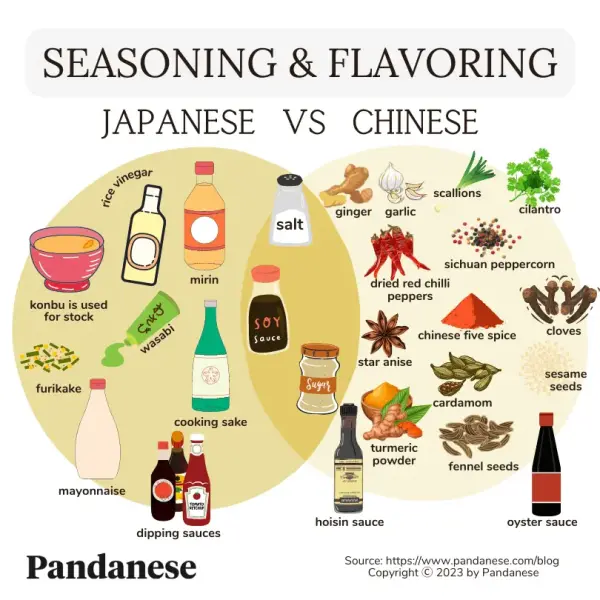
Chinese spices vs vs Japanese seasoning
Japanese flavors, seasonings, and spices
Japanese food and seasonings are known for their delicate balance and umami-rich profiles.
You will notice that the Japanese prefer seafood flavors and umami. Umami is often described as having a savory or meaty taste, and it can be found in mushrooms and aged cheese, for example. Overall, umami enhances the overall flavor profile of dishes and contributes to the pleasant taste experience.
The use of various spices in Japanese food is not too strong. Japanese seasoning and flavors are cooked with salt, sugar, rice vinegar, soy sauce, konbu (for Japanese soup stock), cooking sake, and mirin.
There is also soy sauce, wasabi, mayonnaise, furikake (Japanese rice seasoning), sesame oil, and various sauces (ponzu, unagi, tonkatsu, okonomiyaki). Still, these are mostly used as additional toppings rather than being cooked.
Thus, many traditional Japanese meals keep the natural taste of each ingredient, as seen in miso soup, onigiri, and a simple Japanese breakfast.
Chinese flavors, seasonings, and spices
Chinese flavor and seasonings feature a blend of sweet, savory, sour, and spicy notes.
Chinese cooking uses ingredients like soy sauce, oyster sauce, hoisin sauce, ginger, garlic, and various spices into Chinese cuisine adds depth and complexity to the dishes, complementing the natural flavors of the ingredients used.
Spices include salt, sugar, dried red chili peppers, Sichuan peppercorn, star anise, Chinese five spice powder, turmeric powder, cloves, sesame seeds, fennel seeds, and cardamom.
These spices, along with herbs like scallions and cilantro, help create diverse flavors in various Chinese dishes that are enjoyable to eat making Japanese vs Chinese food quite different.
Japanese vs Chinese dining etiquette
When dining in Japan or China, there is more to the experience than just food. Both of these cultures are filled with customs and etiquette steeped in tradition.
Generally, it's common to see chopsticks being used in both cultures.
Additionally, before and after any Japanese meal saying "itadakimasu" and "gochisousama deshita" respectively is to show appreciation for the meal. Chopsticks for most meals, but chopstick etiquette includes not pointing with them or sticking them vertically in rice. Moreover, slurping noodles is considered acceptable and a sign of enjoyment.
On the other hand, Chinese dining etiquette emphasizes communal dining and the concept of "family-style" sharing. So meals are served with various dishes together on the table for everyone to take. Similar to Japanese chopstick etiquette, it is best not to put them vertically in a rice bowl.
Furthermore, both dining cultures emphasize the importance of showing respect and gratitude to the hosts and other diners. Understanding and respecting these dining etiquettes enhances the overall dining experience.
Frequently asked questions
Is Chinese food the same as Japanese food the same?
No, they are not the same. However, you can see each culture's influences on each other if you look closely. Generally, Chinese food has bold and diverse flavors, while Japanese food focuses on simplicity and freshness, highlighting the ingredients' natural flavors.
How are Chinese and Japanese cuisine similar?
Chinese and Japanese cuisines share certain similarities despite having distinct culinary traditions. Here are some similarities:
Use rice and noodles: Both are considered a staple food in both cultures
Pickled and fermented: A common food preservation method for both cultures
Tea Culture: Green tea is a common beverage in both countries. Check out our article about the various Chinese tea out there: Your Complete Guide to Different Types of Chinese Tea
Which is healthier, Chinese or Japanese food?
Both Chinese and Japanese cuisines can offer healthy options. The best way is to know which food is healthier, dishes with vegetables, lean proteins, and whole grains, while limiting added sugars, sodium, and fried foods. Also, eating in moderation is key for the overall diet balance.
In closing
Exploring the culinary journey of Japanese and Chinese cuisines reveals a fascinating world of flavors, cooking techniques, and dining traditions.
Both cuisines have unique characteristics that showcase the rich cultural heritage of each country. Ultimately, the choice between Japanese vs Chinese food comes from personal preferences and individual tastes.
Tammy Dang is the project manager for Pandanese. She specializes in writing learning tips, educational resources, comparison articles, and content related to Chinese culture.
The easiest way to learn Chinese & build vocabulary

